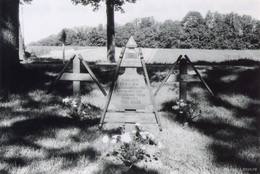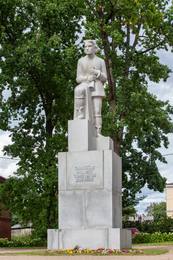About the national patriot First Lieutenant Vili Gelbi
The fate of Lieutenant Colonel Vilis Gelbe (1890-1919) reflects the difficult situation in the formation of our state and army, as well as the assessment of these events.
With the proclamation of the Latvian state on November 18, 1918, the Latvian War of Independence and the work of building the armed forces began. In the first ranks of the Latvian volunteer soldiers was the naval lieutenant Vilis Gelbe, who was born in Courland.
Immediately after the proclamation of the Latvian state, the Red Army invasion began and the provisional government of Kārlis Ulmanis took refuge in Liepāja. In February 1919, with the help of the Estonian army, the liberation of Latvia from the north began and the first mobilizations of the Latvian troops to be formed in Tērbat took place in the vicinity of Rūjiena, which, under the command of Colonel Jorģis Zemitāns, became the North Latvian Brigade. On February 22, 1919, Vilis Gelbe had to assume the duties of the commandant of the Valmiera district. He was one of those who practically worked on the creation of the North Latvian Brigade, which, according to the agreement with Estonia, was formed under the command of the Estonian army.
The Northern Latvian Brigade fought not only against the Bolsheviks, but also against the Landeswehr and the Iron Division in the Battle of Cēsis. Northern Latvian soldiers mobilized in the Rūjiena area also fought in subsequent battles of the War of Independence.
The last order of the Valmiera district commander, Lieutenant Colonel V. Gelbe, was issued on May 6, 1919. What were the real reasons for his forced resignation, due to which he had to resign from his post, is unknown. In the records, not a single complaint or reprimand was found about his actions, neither from the local population, nor from his subordinate service members, nor from the Latvian superiors. It is even unbelievable in such difficult conditions in which he had to work and be that “monster” who, in the name of the noble idea of Latvian independence and freedom, was forced to deprive peasant families of almost the last breadwinner, the last horse and a piece of bread. However, with his energetic actions, sensitive understanding and tact, instead of possible hatred and general contempt, he gained the respect and gratitude of the northern Latvians and later the entire Latvian people. The reason may have been V. Gelbe's March 27 report – a protest against the looting of Latvian farmsteads by Estonian soldiers and officers. It was a bold, even audacious and risky step.
As the liberation of the territory of Northern Latvia continued, it became possible to perform similar service closer to Limbaži and Ķirbiži, where V. Gelbe's family lived. The last stage of Vilis Gelbe's activity took place in the position of commandant of the city and district of Limbaži (appointed by order of Jānis Miglavas on June 2, 1919), which he had to perform mainly during the Battle of Cēsis, in one of the most important districts of the war. Everything had to start again from scratch. The first major mobilizations in Limbaži took place on June 5, 6, and 7. First Lieutenant Gelbe also had to take care of controlling the situation in the area up to the Gauja River, where enemy forces were concentrated.
On June 10, a truce was signed in Cēsis, which was to last until June 20. Both warring sides used this time to replenish their forces.
J. Ozoliņa writes in his June 16 report about Lieutenant Gelbi: "...who is currently very busy organizing a new commandant's district in Vidriži. Mobilizations of people and horses have been announced in the new Vidriži district on June 18, 19, and 20, in which (...) I must also participate."
The armistice had not yet ended, but everything indicated that fighting would soon begin. V. Gelbe, like most Latvians and Estonians in Northern Latvia, did not think that these battles would begin so soon, and trusted the armistice agreement with the Germans, which had been concluded through the mediation of the Allies.
Fully understanding and aware of the decisiveness of the upcoming battles, he prepared for them with great dedication, sparing neither his own nor others. He exerted all his strength, even if it was difficult for the people of Limburg to believe in the possibilities of freedom for the Latvian people. And he succeeded.
Without waiting for the end of the armistice, on June 19, the flank guard of the German railway division stationed in the vicinity of Inčukalns, led by Captain Blankenburg, was the first to begin the march towards Limbaži.
On June 19, Vilis Gelbe fell in battle against the German Iron Division troops near Vidriži Manor. His brutally mutilated body was only found on June 21.
Caught in the crossfire between the attacking Landeswehr and allied Estonian troops, Lieutenant Gelbe and his small group of soldiers did not retreat to the Estonians, but bravely took the first blows, delaying the Germans' further advance towards Limbaži for several hours. The Estonian 9th Infantry Regiment managed to prepare for the blow, preventing the capture of the city of Limbaži by the German forces, defeating them and starting a successful pursuit of the enemy. Thus, they disrupted the entire German strategic plan. The flank guard was unable to connect with its main forces, and these battles of Limbaži – Lielstraupe – Cēsis – Rauna from June 19 to 23, 1919 convincingly ensured a favorable outcome of all the Cēsis battles.
Taking into account all of V. Gelbe's contributions to the establishment of the Northern Latvian Brigade and the freedom struggle in general, he was posthumously awarded the Lāčplēsis War Order.
It is interesting that the first initiatives to award the most heroic freedom fighters came directly from V. Gelbe – at that time the Valmiera district commandant in Rūjiena. It was back in April 1919, when he recommended in his report to J. Zemitāns to award the bravest soldiers of Rūjiena with the Order of Imanta, III class. “The proposal deserves attention, but it was not possible, because such an order did not yet exist. The name of the Order of Imanta appeared again on March 6, 1920, when JALiberts (one of the members of the Commission for the Establishment of the Statutes of the Order of War) in the presentation submitted to the Minister of Security K. Ulmanis on the establishment of the order of war proposed the name of the Order of Imanta with the motto “It is better to drown in one’s own blood than to perish under a foreign yoke!””
However, it was the legend of Lāčplēsis, created by previous Latvian generations, cherished by Pumpurs and Rainis, that became a reality at the end of 1919, and the Lāčplēsis War Order was established during the culmination of the War of Independence – on November 11, 1919.
Back in the spring of 1916, Midshipman Gelbe from Kronstadt had shouted:
"It is enough to bear the chains of slaves,
It's pretty suffocating in dark walls!"
But in the summer of 1919, his cherished dreams of liberating his homeland from all its oppressors were about to turn from hope into reality. The fulfillment of his dreams was so close... .
The inscription on the Gelbe monument reads:
"People who pass by me,-
ignited by love for the fatherland!
For the beloved fatherland
"I pledge my life."
Source: Jānis Ulmis, “LOVE FOR THE FATHERLAND...”. Cavalier of the Lāčplēsis War Order, Naval Lieutenant Vilis Gelbe, on the Formation of the Northern Latvian Armed Forces and the Battles of Cēsis of the Latvian Liberation War, 2018, Publisher: Limbaži Museum
Related timeline
Related topics
Related objects
Monument to Naval Lieutenant, L.k.o.k. Vilis Gelbes (1890-1919)
Located at the Limbaži Jūras Street Cemetery, Jūras Street 56, Limbaži
On display is a monument unveiled on September 10, 1922 by the then President of Latvia, Jānis Čakste, which contains the dedication of the poet Vilis Plūdonis to Vilis Gelb:
"My people, who pass by me, burn with love for your fatherland,
"For the sake of my beloved fatherland, I pledge my life."
Vilis Gelbe (1890-1919) was born in Courland, in Zemīte parish, but was also closely connected to the Limbaži side, because when the Latvian War of Independence began, he returned to Latvia from St. Petersburg and joined the North Latvian Brigade.
In May 1919, V. Gelbi commanded in Limbaži, he became the military commandant of the area and was able to inspire the local men and even very young boys to join the army.
V. Gelbe's activities in Limbaži and its surroundings at that time were very significant; his duties included not only maintaining order in the city and its surroundings, but also mobilization, providing food for soldiers and horses, and resolving many other issues that could not be included in orders and instructions. The commandant's team organized by him acted as a coordinated mechanism to provide the North Latvian Brigade with the most effective assistance possible. The commandant's team went to the aid of the regular army in special cases, and he set an example for the new soldiers. V. Gelbe was the first officer of the Latvian army who proposed awarding his subordinates with the Order of Imanta, Class III. The order did not yet exist. The name of Imanta appeared in public only on March 20, 1920, when a presentation on the establishment of a military order was submitted to the Minister of Security, Kārlis Ulmanis. However, the name of Lāčplēsis was chosen for the order.
During the Battle of Cēsis, Vilis Gelbe died - on June 19, 1919, during a reconnaissance mission. Gelbe was later awarded the Lāčplēsis War Order, but historians believe that his contribution has not been properly appreciated. This is mainly due to Gelbe's membership in the North Latvian Brigade.
The so-called Southern Latvian Brigade, initially commanded by Oskars Kaplaks and later by Jānis Baložs, competed with the Northern Latvian Brigade, commanded by Jorģis Zemitāns.
Monument in memory of the fallen soldiers of the Latvian Liberation War
The monument is located next to Limbaži Sv. St. John's Lutheran Church, Lībiešu Street 2. There is a memorial to the fallen soldiers of Limbaži and the surrounding area and to Lieutenant General Vilis Gelbe (1890-1919), who fell in the battle against the Germans on June 19, 1919 in Vidriži.
The monument of Lieutenant General Viļis Gelbe can be seen in the Limbaži cemetery in Jūras Street.
A memorial in Vidriži at the place where LKOK Vilis Gelbe and two soldiers from his team fell.
In Vidriži, at the turnoff to Lēdurga, during the War of Independence on June 19, 1919, naval lieutenant Vilis Gelbe and two soldiers fell in battle.
Vilis Gelbe was buried in the Limbaži cemetery. For his heroic deed near the Vidriži manor, Vilis Gelbe was awarded the Lāčplēsis War Order, 3rd class (No. 895).
Currently, three Pemin crosses, installed in 1989, can be seen at the battle site.
On June 22, 1934, a bronze memorial plaque modeled after the artist Stefans Bercs was unveiled near the maple tree growing in the manor park. Already at the beginning of the communist occupation in the autumn of 1940, the memorial plaque disappeared. The maple tree to which it was nailed also perished. When the Awakening began, on June 19, 1989, on the 70th anniversary of the death of Gelbe and two soldiers from his team – Corporal Krustiņš and Private Krūze – at the crossroads where the memorial plaque once stood, at the initiative of the Environmental Protection Club and the Limbaži district branches of the Latvian Popular Front, three wooden crosses made in the folk style by Jānis Eglītis were installed. By decision of the Limbaži district executive committee in April 1991, this memorial site was included in the list of historical monuments of local importance.
Monument “Tālavas taurētājs”
Located in Rūjiena Center Square.
The three-meter-high image of an ancient Latvian guard soldier, carved from gray Finnish granite, called the “Tālavas trumpeter”, is placed on a three-meter-high granite pedestal, but the total height of the monument reaches 7.5 meters. In the initial sketches and models, K. Zemdega had placed a sword in the warrior’s hands, which was later replaced with a trumpet. The monument was unveiled on August 15, 1937.
This monument reflects the difficult situation in the formation of our state and army, as well as the assessment of these events. Immediately after the proclamation of the Latvian state, the Red Army invasion began and the provisional government of Kārlis Ulmanis found refuge in Liepāja. In February 1919, with the help of the Estonian army, the liberation of Latvia from the north began and the first mobilizations of the Latvian troops being formed in Tērbatas took place in the Rūjiena area, which, under the command of Colonel Jorģis Zemitāns, became the North Latvian Brigade. The North Latvian Brigade fought not only against the Bolsheviks, but also against the Landeswehr and the Iron Division in the battles of Cēsis. The North Latvian soldiers mobilized in the Rūjiena area also fought in subsequent battles of the War of Independence. After the war, the main laurels of victory went to General Jānis Balodis and the South Latvian Brigade commanded by him, but the North Latvian Brigade was often forgotten. The planned monument to the North Latvian Brigade in Rūjiena also took a long time to be created, and the monument, unveiled in 1937, was officially promoted as a monument to the liberation of the Rūjiena region and in memory of the fallen soldiers, without mentioning that all the regiments that were part of the North Latvian Brigade had their beginnings in Rūjiena.
The monument is not only a popular tourist attraction for Latvian and Estonian tourists, which is to some extent a starting point for visiting several other War of Independence memorial sites in Rūjiena, but the "Tālavas tauretājs" is also a stopping point for visits by Estonian and Latvian state and local government officials of various levels.
The Rūjiena Liberation and Fallen Soldiers Monument, more commonly known as the "Tālavas tauretājs" (Far-away Horner), was included in the list of state-protected cultural monuments on October 29, 1998 as an art monument of national importance (monument protection registration number 4522).
Monument to the Liberators of Northern Latvia
Located in the center of Plāčis near the Inčukalns - Valkas highway (A3). Next to the bus stop and Straupes Community Center.
The monument created by Teodors Zaļkalns to the liberators of Northern Latvia in the Battle of Cēsis in 1919 is visible.
On a three-tiered base, two travertine pillars are placed, on which a travertine block rests. On its front, a bas-relief depicts a horse harnessed to a plow and a plowman, who holds the reins in his right hand and a sword in his left. On the back of the monument is carved a text, which concludes with the lines of the poet Eduards Virza:
TO THE LIBERATORS OF NORTHERN LATVIA
WHILE ONE GRAIN IS SOWED IN THIS FIELD
YOU WILL BE PRAISED AND HONORED
The monument was unveiled on November 8, 1931. The opening was attended by President Alberts Kviesis.




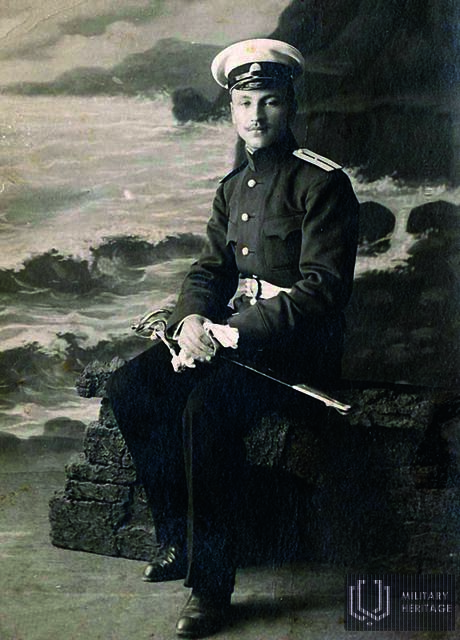
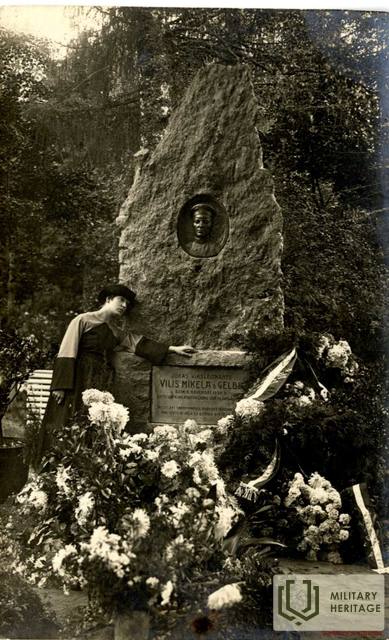
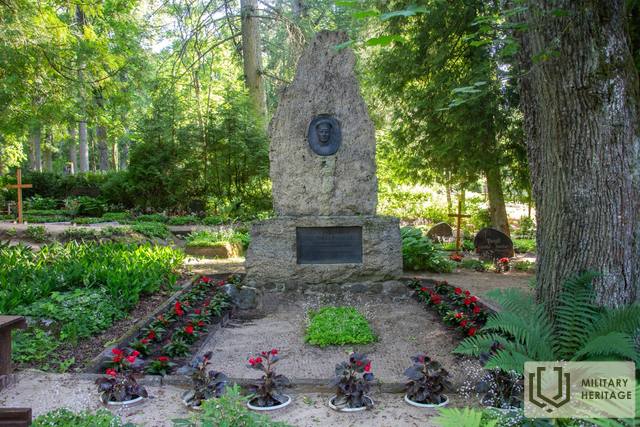
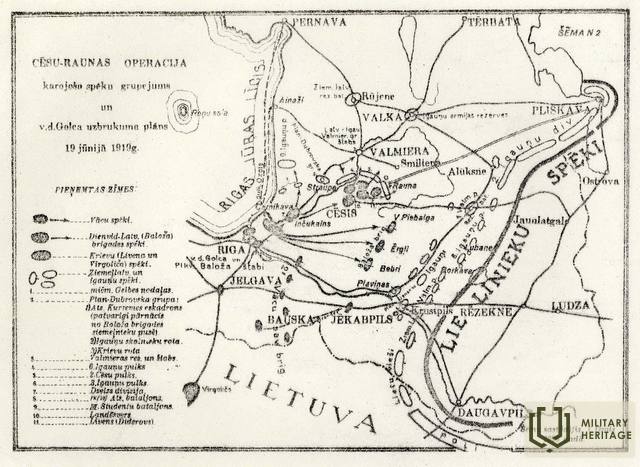
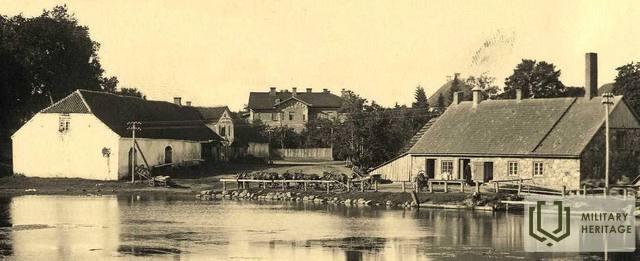
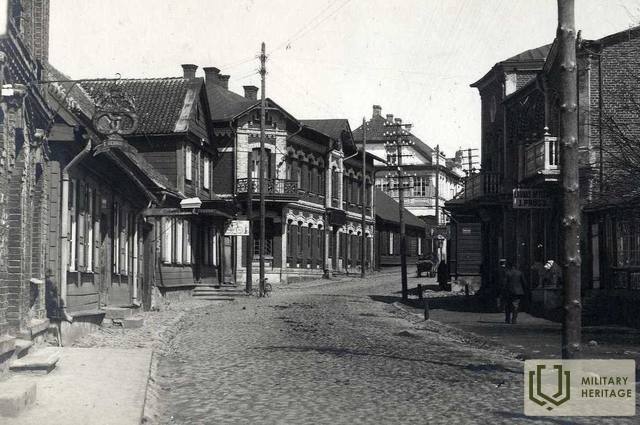
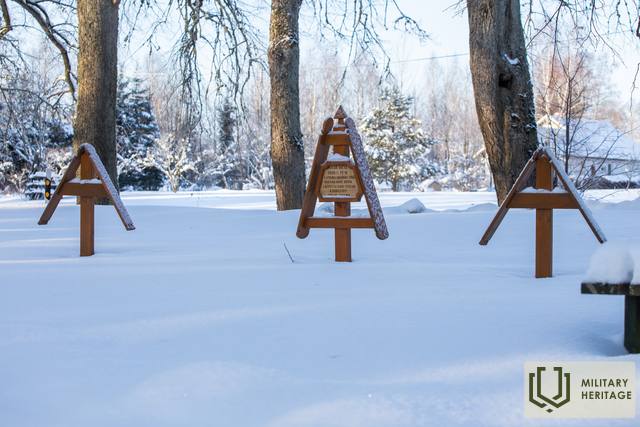

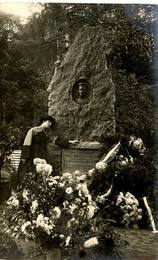
![Limbaži. President J. Čakste unveils a monument in Limbaži to those who fell in World War I. Unveiling of the Latvian Freedom Struggle Monument [1923]. Source: The National Library of Latvia's digital collection "Lost Latvia".](/g/Poi/00403/44213.png?size=260)
